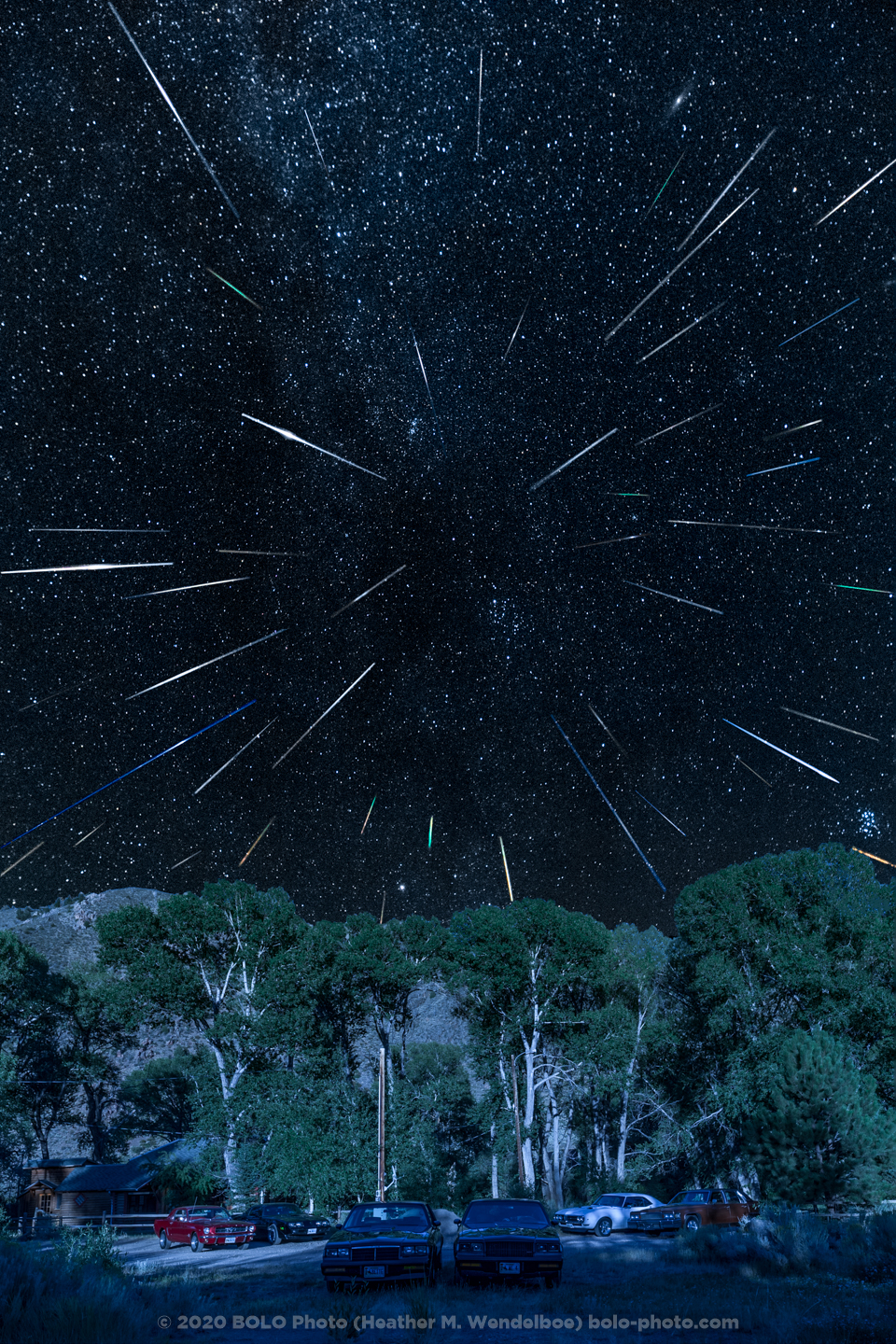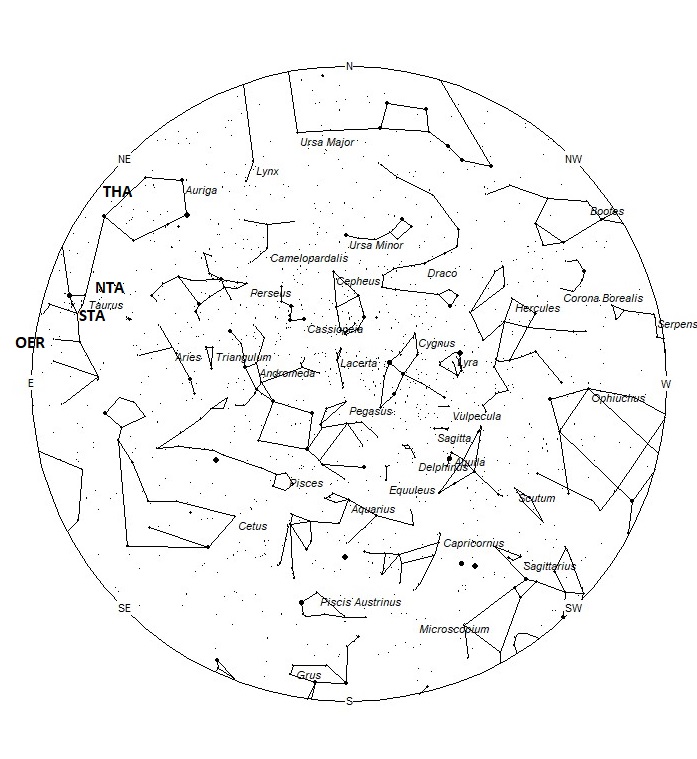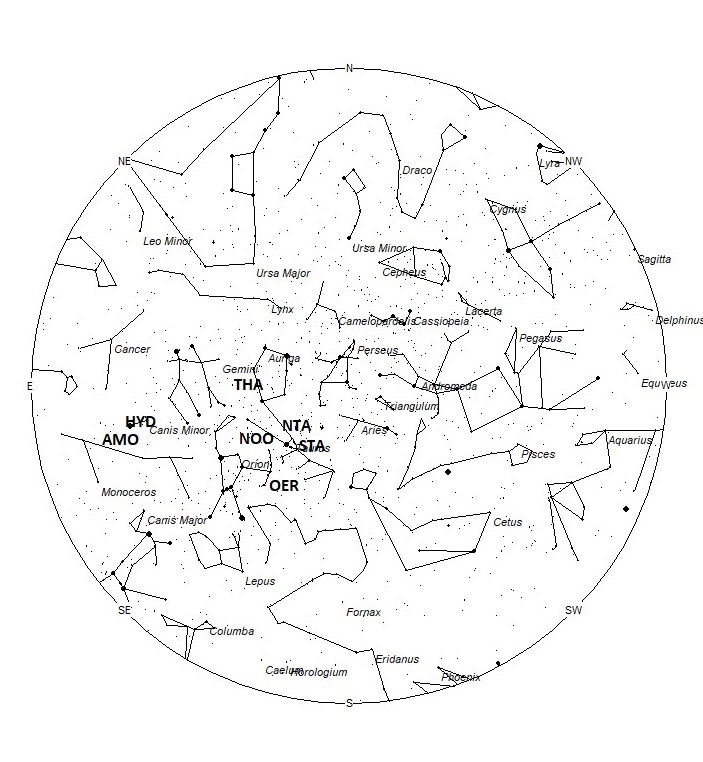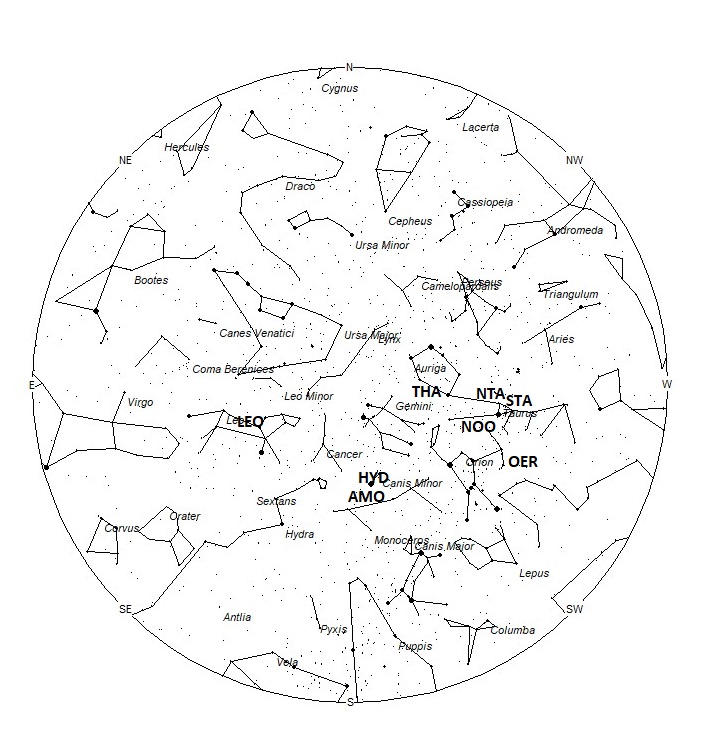
During this period, the moon reaches its first quarter phase on Saturday November 21st. At this time, the moon is located 90 degrees east of the sun and sets near 2300 local standard time. As this period progresses, the waxing gibbous moon will set later with each passing night, shrinking the available time to view under dark, moonless skies. The estimated total hourly meteor rates for evening observers this week is near 3 as seen from mid-northern latitudes and 2 as seen from tropical southern locations (25S). For morning observers, the estimated total hourly rates should be near 21 as seen from mid-northern latitudes (45N) and 14 as seen from tropical southern locations (25S). The actual rates will also depend on factors such as personal light and motion perception, local weather conditions, alertness, and experience in watching meteor activity. Evening rates are reduced during this period due to interfering moonlight. Note that the hourly rates listed below are estimates as viewed from dark sky sites away from urban light sources. Observers viewing from urban areas will see less activity as only the brighter meteors will be visible from such locations.
The radiant (the area of the sky where meteors appear to shoot from) positions and rates listed below are exact for Saturday night/Sunday morning November 21/22. These positions do not change greatly day to day so the listed coordinates may be used during this entire period. Most star atlases (available at science stores and planetariums) will provide maps with grid lines of the celestial coordinates so that you may find out exactly where these positions are located in the sky. A planisphere or computer planetarium program is also useful in showing the sky at any time of night on any date of the year. Activity from each radiant is best seen when it is positioned highest in the sky, either due north or south along the meridian, depending on your latitude. It must be remembered that meteor activity is rarely seen at the radiant position. Rather they shoot outwards from the radiant, so it is best to center your field of view so that the radiant lies at the edge and not the center. Viewing there will allow you to easily trace the path of each meteor back to the radiant (if it is a shower member) or in another direction if it is sporadic. Meteor activity is not seen from radiants that are located far below the horizon. The positions below are listed in a west to east manner in order of right ascension (celestial longitude). The positions listed first are located further west therefore are accessible earlier in the night while those listed further down the list rise later in the night.
These sources of meteoric activity are expected to be active this week.
.
The Southern Taurids (STA) are active from a large radiant centered at 04:16 (064) +16. This area of the sky is located in western Taurus, 3 degrees northwest of the 3rd magnitude variable star known as Prima Hyadum A (gamma Tauri). This source is best placed near midnight LST when it is located highest in the sky. Current hourly rates would be near 2 no matter your location. With an entry velocity of 27 km/sec., most activity from this source would possess medium-slow velocities.
The Northern Taurids (NTA) are active from a large radiant centered at 04:21 (065) +25. This area of the sky is located in northern Taurus, 1 degree south of the faint star known as chi Tauri. This source is best placed near midnight LST when it is located highest in the sky. Current hourly rates would be near 3 as seen from the northern hemisphere and 2 as seen from south of the equator. With an entry velocity of 27 km/sec., most activity from this source would possess medium-slow velocities.
The last of the omicron Eridanids (OER) may be seen this week from a radiant located at 04:42 (071) +02, which places it on the Taurus/Orion border, 2 degrees west of the 4th magnitude star known as Pi5 Orionis. These meteors may be seen all night long but the radiant is best placed near midnight LST when it lies on the meridian and is located highest in the sky. Current hourly rates should be less than 1 no matter your location. With an entry velocity of 29 km/sec., the average omicron Eridanid meteor would be of medium-slow velocity.
The November Orionids (NOO) are active from a radiant located at 05:24 (081) +16. This area of the sky lies on the Taurus/Orion border, 9 degrees north of the 2nd magnitude star known as Bellatrix (gamma Orionis). This radiant is best placed in the sky near 0300 LST, when it lies highest above the horizon. This stream is active from November 7 through December 17, with maximum activity occurring on November 29. Rates should be 2 per hour as seen from the northern hemisphere and 1 as seen from south of the equator. With an entry velocity of 43 km/sec., most activity from this radiant would be of medium speed.
The November theta Aurigids (THA) were discovered by Dr. Peter Brown using the Canadian Meteor Orbit Radar. This stream is active from November 17 through December 1, with maximum activity occurring on November 26. The radiant currently lies at 06:04 (091) +35, which places it in central Auriga, 3 degrees southeast of the 3rd magnitude star known as Mahasim (theta Aurigae A). This area of the sky is best placed in the sky near 0200 LST, when it lies highest above the horizon in a dark sky. Rates should be less than 1 per hour no matter your location. With an entry velocity of 33 km/sec., most activity from this radiant would be of medium-slow velocity. These meteors are expected to be faint and may be difficult to observe unless viewing conditions are near optimum. Lastly, the radiant drift for this source resembles that of the Geminids, if that source was extended back into November. Therefore, these meteors may actually be early members of the Geminid meteor shower, which is active from December 1-22.
The sigma Hydrids (HYD) were discovered during the Harvard Meteor Project of the mid-1950’s by R.E. McCrosky & A. Posen. The activity period extends from November 14 through December 21 with peak activity occurring on December 8th. The source of these meteors is currently located at 07:31 (113) +06, which places it in central Canis Minor, just 2 degrees northwest of the brilliant zero magnitude star known as Procyon (alpha Canis Minoris A). This area of the sky is best placed near 04:00 LST when the source of these meteors lies highest in the sky. Current rates are expected to be less than 1 per hour no matter your location. With an entry velocity of 61km/sec, most of these meteors would appear swift.
The alpha Monocerotids (AMO) produced a modest outburst last year. If any enhanced rates occur this year it will most likely occur on Saturday morning between 9-11 Universal Time. This timing favors North America. For the remainder of the period, AMO rates are normally less than 1 per hour no matter your location. At maximum, the source of these meteors is located at 07:47 (117) +01. This area of the sky is located in southern Canis Minor, 5 degrees southeast of the zero magnitude star known as Procyon (alpha Canis Minoris A). With an entry velocity of 63km/sec, most of these meteors would appear swift.
The Leonids (LEO) are still active from a radiant located at 10:35 (159) +20. This position lies in central Leo, 3 degrees east of the 2nd magnitude star known as Algieba (gamma Leonis A). The Leonid radiant is best placed during the last hour before morning twilight when the radiant lies highest in a dark sky. Leonids may be seen from the southern hemisphere but the viewing conditions are not quite as favorable as those north of the equator. Rates are expected to be near 2 per hour as seen from the northern hemisphere and 1 per hour as seen from south of the equator. With an entry velocity of 70 km/sec., most activity from this radiant would be of swift speed with numerous persistent trains on the brighter meteors.
As seen from mid-northern hemisphere (45N), sporadic morning rates would be near 12 per hour as seen from rural observing sites and 2 per hour during the evening hours. As seen from the tropical southern latitudes (25S), one would expect to see approximately 8 sporadic meteors per hour during the last hour before dawn as seen from rural observing sites. Evening rates would be near 1 per hour. Locations between these two extremes would see activity between the listed figures.
| SHOWER | DATE OF MAXIMUM ACTIVITY | CELESTIAL POSITION | ENTRY VELOCITY | CULMINATION | HOURLY RATE | CLASS |
| RA (RA in Deg.) DEC | Km/Sec | Local Standard Time | North-South | |||
| Southern Taurids (STA) | Nov 03 | 04:16 (064) +16 | 27 | 00:00 | 2 – 2 | II |
| Northern Taurids (NTA) | Nov 12 | 04:21 (065) +25 | 27 | 00:00 | 3- 2 | II |
| omicron Eridanids (OER) | Nov 05 | 04:42 (071) +02 | 29 | 00:00 | <1 – <1 | IV |
| November Orionids (NOO) | Nov 29 | 05:24 (081) +16 | 43 | 01:00 | 2 – 1 | II |
| November theta Aurigids (THA) | Nov 26 | 06:04 (091) +35 | 33 | 02:00 | <1 – <1 | IV |
| sigma Hydrids (HYD) | Dec 08 | 07:31 (113) +06 | 61 | 04:00 | <1 – <1 | II |
| alpha Monocerotids (AMO) | Nov 21 | 07:47 (117) +01 | 63 | 04:00 | <1 – <1 | III |
| Leonids (LEO) | Nov 17 | 10:35 (159) +20 | 70 | 07:00 | 2 – 1 | I |
 American Meteor Society
American Meteor Society


